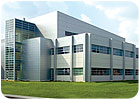
At Purdue University's new Birck Nanotechnology Center, a single speck of dust could spoil a whole experiment. To help prevent such a scenario, the building's air-handling equipment employs a new grounding device that extends motor life.
A single speck of dust could spoil a whole experiment at Purdue University's new Birck Nanotechnology Center. To prevent such a scenario, the building's HVAC system has to be fast, forceful, and flawless. Such high performance is attained by carefully selected air-handling equipment that includes the AEGIS SGR™, a new grounding device that extends motor life.
Adjacent to the Purdue campus in West Lafayette, IN, the three-story, 71,000-sq-ft Birck Center has many state-of-the-art laboratories for advanced nanotechnology research. Some predict this emerging science could have a big impact on society, possibly yielding new high-strength materials, microscopic devices, or miniature computers constructed atom by atom. "Tiny" is an understatement. Since "nano" means one-billionth, a nanometer is a billionth of a meter, only about 10 atoms wide. A dust particle could be 10 times larger than the group of atoms with which scientists in the new lab might be working.
HALTING MICROSCOPIC EXPANSION
The Birck Center's HVAC system maintains the labs at 30% to 50% rh at all times and replaces the air at least 15 times per hour. Temperature is allowed to vary by no more than 1°C; a rise of just one degree causes microscopes and other equipment to expand by an amount equivalent to thousands of atoms.Many of the labs (more than 20,000 sq ft) are cleanrooms. To call them "controlled environments" would be another understatement. Equipped with vibration-isolation equipment and special filtration systems to keep the air nearly free of dust particles, they are so tightly controlled that some have as many as 120 ach, yet are not allowed temperature changes of more than 0.1°C.
Key to maintaining such conditions are high-volume fans equipped with VFDs that automatically change fan speed to adjust to the weather outdoors, laboratory occupancy levels, and other factors. The contract to supply eight of these fans went to Colby Equipment Co., which represents 20 manufacturers of industrial and commercial air-handling equipment throughout the Midwest. Colby selected fans manufactured by Greenheck Fan Corp.: four 25-hp fans, each capable of moving more than 20,000 cfm of air; and four 5-hp fans, capable of moving more than 5,000 cfm each.
Colby's Tom Hall, a Purdue alumnus, knew that without grounding devices, VFD-induced currents would discharge through the fans' AC motor bearings, causing fusion craters on the bearing race walls. This phenomenon would continue until the race became severely pitted and the bearings (and motor) failed. Prior to failure, the pitting may cause noise and vibration that is magnified and transmitted by HVAC ducts. Because many of today's AC motors have sealed bearings, electrical damage from VFD-induced shaft currents has become the most common cause of bearing failures. The resulting repairs, downtime, and lost production can be costly.
SQUARELY ON THE GROUND
In his search for reliable grounding devices that would optimize the performance and durability of the variable-speed fans, Hall concluded that conventional metal grounding brushes would be difficult to attach since the fans had already been installed. An Internet search turned up Electro Static Technology, a division of Illinois Tool Works and a Maine-based manufacturer of the AEGIS SGR Conductive MicroFiber™ Brush. After speaking with the company's sales manager, Hall purchased eight SGRs.A ring of conductive microfiber brushes that encircles a motor shaft, the SGR prevents electrical damage to AC motor bearings and extends motor life by providing a safe path to ground for harmful shaft currents. Maintenance-free, the SGR is unaffected by dirt, grease, or other contaminants and provides long-lasting protection. Its conductive microfibers work with virtually no friction or wear, have no rpm limitations, and last for the life of the motor.
Because SGRs are offered in standard sizes to fit virtually any NEMA motor from 1 to 1,500 hp, Electro Static Technology was able to supply units for the two motor types that power the Birck Center fans.
"All the installer had to do was remove the motor pulley, slide the ring onto the shaft, lock it in position with two screws, and slide the pulley back on," Hall recalled.
"Purdue has too much at stake for these fans to fail," Hall mused. "I'd hate to have the glory of a scientific breakthrough go to some other school!"
